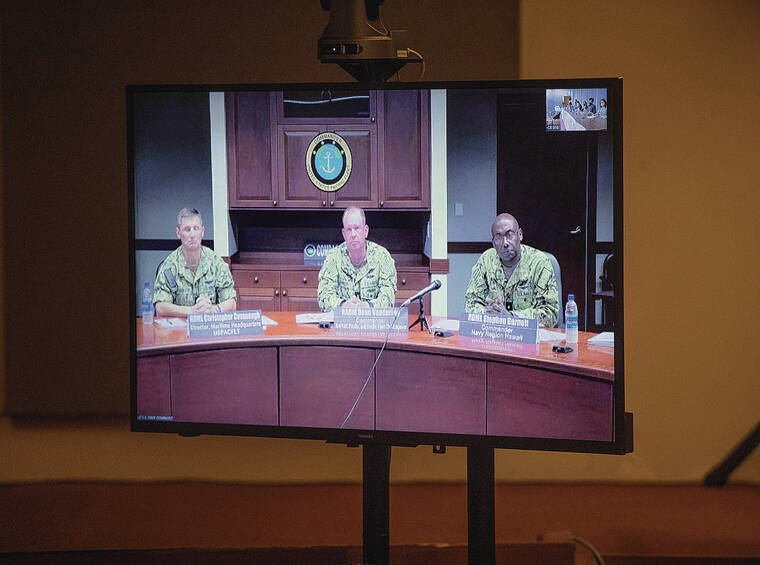Hawaii lawmakers Tuesday vented their frustration at top Navy officials for not submitting an adequate plan to state regulators for draining their Red Hill fuel facility and questioned the Navy’s lengthy, 2-1/2-year time frame for completing the defueling operation.
Sen. Donna Mercado Kim said public trust in the Navy had been eroded even more by the Navy’s defueling plan. “It troubles me that it was so incomplete, missing plans, missing details,” said Kim during a legislative briefing Opens in a new tab before the Senate Committee on Health and House Committee on Health, Human Services and Homelessness, which included presentations by the Navy and the state Department of Health.
DOH, which has regulatory authority over Red Hill, said last week that it would reject the Navy’s defueling plan because it lacked detail. During Tuesday’s briefing, DOH officials were more explicit about their concerns.
“The highly anticipated defueling plan was disappointing,” said DOH’s
deputy director of environmental health, Kathleen Ho. “It lacked substance, specific detail and dates.”
Ho said that the state’s emergency order for shutting the facility set forth a minimum of seven elements that the defueling plan must address. “The submitted plan did not completely address any of these elements,” said Ho.
For example, Ho said that the plan did not include response plans in the event there was another fuel spill during defueling or details about its plans to fix a fire suppression line that was damaged during the November spill. She said the Navy had not built in time for regulators, including DOH and the U.S. Environmental Protection Agency, to review each of the Navy’s five phases.
“We need the Navy to feel the same sense of urgency that we feel,” said Ho.
The Pentagon announced in March that it would permanently shut down the facility after 2021’s water contamination crisis, which sickened hundreds of military families and sparked widespread public outrage.
The defueling plan is just one of many regulatory requirements that the Navy is required to fulfill as it moves to close the facility.
The Navy submitted its plan to DOH by its June 30 deadline. At the time, Navy officials conceded that the 20-page document was inadequate and said that it would provide supplementary information by September.
The plan includes an estimated timeline for defueling. The Navy plans to identify the actions, including repairs, that are needed to defuel by Aug. 31, and estimates that it will take 17 months to issue contracts and complete the repairs as well as train workers. The Navy estimates it will then take three months to review the repairs. It would then take four to eight months to drain the tanks.
The Navy’s timeline has sparked criticism from the Honolulu Board of Water Supply and environmental groups, which worry that in the interim there will be another fuel leak at the facility that will further pollute the environment, including a critical aquifer for southern Oahu that sits just 100 feet below the tanks.
Navy Rear Adm. Stephen Barnett, who assumed command of Navy Region Hawaii in June, replacing Rear Adm. Timothy Kott, said the Navy has no intention of delaying the defueling of Red Hill and is working on the information, including the spill response plan.
“We are going to have to earn your trust providing these documents in a timely manner and doing the defueling as it should be done,” he said. “It should be done safely and it will be done safely. We have to earn that. We need to be transparent though the whole process.”
Critics of the Navy’s timeline have been particularly skeptical of the Navy’s four- to eight-month estimate for draining the tanks.
The Navy says there is currently 104 million gallons stored in 14 underground tanks. Prior to operations ceasing at Red Hill in 2021, the Navy regularly drained the tanks for inspections and maintenance.
Kim asked Navy officials how long it takes to drain one tank.
Rear Adm. Dean VanderLey, commander of Naval Facilities Engineering Systems Command Pacific, said he didn’t know.
However, a 2019 Navy report on Red Hill, submitted to state regulators, states that a tank can be drained within 36 hours. Another Navy report Opens in a new tab, dated August 2021, which lays out different scenarios for draining a tank if there is an emergency leak, also states that a tank can be drained in one to two days.
Barnett, who also said he didn’t know how long it typically takes to drain a tank, stressed that when defueling begins, it will be done slowly to ensure safety.
“It is not going to be a max velocity type of fuel flow,” he said.
At other times during the hearing, it grew awkward as the Navy dodged a question about how video of the
November spill at its Red Hill facility surfaced Opens in a new tab in the media July 5, after Navy officials suggested for months that no such footage existed.
“Can you address the video issue? Why was it not released?” asked Sen. Bennette Misalucha.
Rear Adm. Christopher Cavanaugh, director of U.S. Pacific Fleet Maritime Headquarters, who conducted the Navy’s investigation into 2021’s Red Hill spills and water contamination, said the video was known to the investigative team but didn’t explain why the public wasn’t told about it.
“It is part of the enclosures of the investigation, which are undergoing a release process,” he said.
The Navy also sought to explain why, after years of assuring the public and regulators that Red Hill was a modernized, “rock-solid facility Opens in a new tab,” an outside assessment Opens in a new tab of the facility released in May determined that the facility required extensive repairs just to safely drain it.
The report identified more than 200 repairs that were needed to safely operate the facility that would take an estimated four years to complete. More than 40 of those were cited as critical prior to defueling in order to ensure there wasn’t a catastrophic leak, fire or injury to workers.
“If it takes a year and five months to make the facility safe for defueling, why weren’t these remediation requirements done previously for the last two decades so that we are not here today?” asked Rep. Ryan Yamane. “What happened so that those needed repairs weren’t done, so that it takes over a year to move fuel?”
VanderLey said that many of the identified repairs are “consistent with the types of repairs and maintenance that we have normally done throughout the history of Red Hill.”
“The difference is that instead of just doing those as ongoing maintenance, we are doing them all before starting defueling so that Red Hill is in the highest state of material readiness possible before commencing defueling,” said VanderLey.
He said that other repairs were to create resilience in order to augment safety.






